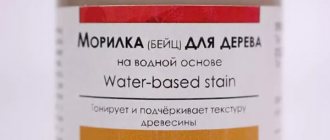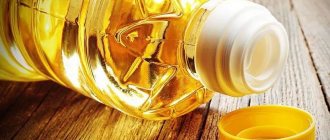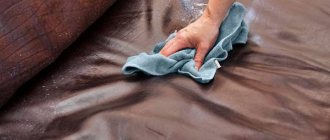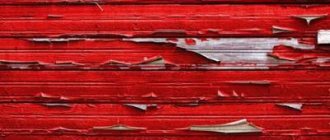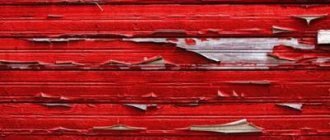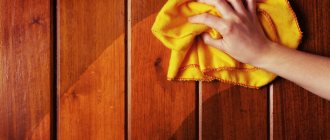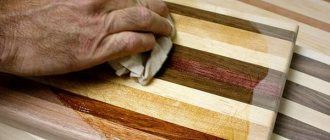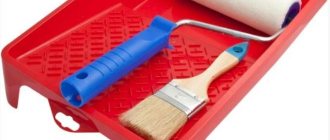In private houses, country houses, and often in apartments, wooden products are used, such as doors, windows, flooring, gazebos, furniture and decorative parts. And no matter how magnificent wood is in its original form, due to the constant influence of external factors and time, it gradually loses its consumer qualities and attractiveness. What to do in such a situation? The answer is very simple: if you want to preserve the natural structure and appearance of wood for many years, stain will help you.
Stain is not paint; it will not hide the texture of the wood (you can see this in the photo)
How can you remove nail polish from linoleum?
One way to remove nail polish from linoleum is pure acetone or gasoline. The method works quickly and efficiently, but has one big drawback - the strong smell of the solvent. You have to choose: a good smell or good linoleum.
Interesting materials:
How much will it cost to replace the screen on an ASUS laptop? How much will it cost to replace the screen on a Lenovo laptop? How much will it cost to replace a laptop keyboard? How much will it cost to replace a laptop fan? How many inches should a laptop be? How many inches are in a standard laptop? How long should a laptop run on battery power? How many dead pixels are allowed on a laptop? How many hertz on a laptop? How much RAM do you need for a laptop?
Mechanical cleaning
The essence of the technique is surface scraping. In other words, this is stripping off the varnish layer using a construction tool - a tsikli, which is a sharpened steel plate with a handle. Moreover, the handle is at an angle to increase pressure on the surface. You can purchase a cycle or make it yourself.
You can remove varnish from a wooden surface using a scraper.
You can do without a special tool by using glass. But this device has a drawback - it quickly becomes dull. If you choose glass, you need to remember to use protective gloves to avoid getting hurt.
If the varnish layer is thin, you can use regular sandpaper. Moreover, it can be used either manually or by attaching sandpaper to an angle grinder. There are three types of grinding machines:
Vibrating machines are the most affordable. This tool can be used to clean furniture.
The working process is as follows: sandpaper is installed on the “sole”, which is used to process the surface. This method of removing varnish is very dusty, but compared to manual processing, this option will give a much more aesthetic surface.
Advice! Don't forget to protect your surroundings from dust. Plastic film will do for this.
The main advantage of mechanical processing compared to chemicals is that toxic and unpleasant-smelling substances are not used. In addition, if you work carefully, this method of cleaning is more gentle on the wood than in the case of chemical compounds. Mechanics have one drawback - the process is long and labor-intensive.
The main disadvantage of mechanical processing is that the process takes a lot of time and effort.
Advice! Since mechanical cleaning takes a lot of time and also requires accuracy, it may be more rational to use the services of a hired specialist. In addition, the specialist is equipped with professional equipment, which will improve the quality of work.
Instructions for removing varnish from a wooden surface
The entire coating removal process consists of four stages.
First stage: applying wash
We wet the brushes in the chemical composition and apply a decent layer to the surface. We proceed from the rule that the brush should be passed over one place only once, without repetition.
Second stage: film
To enhance the washing effect, we organize a compress, for which we cover the surface to be treated with a polyethylene film. The average waiting time for the effect of a compress is from 1 to 4 hours, depending on how many layers are to be removed. A good sign is if the remover changes color and becomes dark brown or brownish, and the varnish begins to swell.
Third stage: removing varnish
After the varnish has become softer, it must be removed with a spatula. The edges of the new spatula are too sharp. Therefore, it is recommended to round them slightly using a sharpening stone. This will make working with wood more accurate.
The pressure on the swollen material must be careful. You probably won't be able to completely get rid of the varnish in one go. Then you need to repeat the operation again. However, it happens that one pass with sandpaper is enough to remove the remaining varnish film.
Fourth stage: neutralization of the chemical composition
Do not forget that the chemical composition remaining on the wooden surface must be washed off either with plain water or with vinegar solution (500 grams of water per 100 ml of vinegar). You need to wash off the remaining chemicals thoroughly, but not for too long, since moisture is harmful to wood, and the surface being treated at this time is deprived of protection. As soon as the washing is completed, the surface should be wiped well, and then the item should be moved to a dry and ventilated place. Moreover, direct rays of the Sun should be avoided. After drying, the wooden product can be re-varnished.
The chemical composition remaining on the wooden surface can be washed off with plain water or vinegar solution
In addition to liquids, spray cans are also used. As a result of spraying the spray, a foam layer appears on the surface being treated. Sprays are easy to use, however, their disadvantage is the ability to wash off only minor layers.
Important! Work with chemical compounds must be carried out in compliance with safety rules. The room must be well ventilated. For protection you need to use special gloves and respirators.
Acetone is also used as a solvent. First of all, a fabric compress is made, thoroughly soaked in acetone. Then the compress is applied to the areas intended for cleaning. Cover the compress with plastic wrap and wait 10-15 minutes.
Note! Removing the varnish layer on furniture or chipboard panels can damage the surfaces, as the decorative film can be damaged. The best material for removing varnish is natural wood.
Treatment with chemical compounds
Treating wooden surfaces with chemicals (also called stripping) is one of the most popular methods of removing varnish when it comes to delicate surfaces of furniture or other delicate objects. The chemical compositions can be powders, gels, specialized liquids or a regular solvent.
The choice of a specific option depends on the task at hand. When it comes to shellac, denatured alcohol is best. Liquids are most applicable to surfaces where there are not many layers - up to three. The fact is that the liquid tends to erode quickly, which is why it is simply not able to absorb deeply enough. Powder chemistry is the best choice for large-scale work, since such materials can be preserved for a long time. But gels and paste-like materials are best suited for removing a significant number of layers of varnish or paint.
Denatured alcohol is best for removing shellac.
Recommendation: powders are created in this consistency for ease of storage and transportation. They should be used diluted with water to form a thick paste-like mass.
It is best to apply the mixture in a vertical position. This is not only more correct from a technological point of view, but also more convenient. Gels and pastes can remove up to a dozen layers of old coating at a time.
Nail polish removal methods
It must be said right away that only the most popular surface cleaning methods are covered here. There is no universal recipe that is applicable in all situations.
The choice of method depends on many variables, including:
- The type of base is of considerable importance, since it makes a difference what exactly needs to be cleaned - furniture or parquet.
- Varnish composition. Different options are relevant for different compositions.
- Layer thickness. It's one thing to remove one layer, quite another to remove many old layers.
Using wood stain
The wood surface should be painted with stain in the same way as with regular paint. The only thing is that this impregnation dries very quickly, so you should work just as quickly, but carefully .
Before completing the work, you must not allow the stain layer to dry, otherwise a seam in this place will be clearly visible, different from the rest of the surface. That is why you should not put a lot of solution on the brush.
To paint a wooden surface with stain, use:
- Paint brush.
- Foam roller.
- Automatic or manual sprayer.
The stain is applied parallel to the direction of the wood grain and therefore should not be applied to another section unless the first is finished. In the place where the two sections are connected, it is necessary to ensure that the applied layers of impregnation do not overlap each other.
Thanks to stain, wood acquires a refined and excellent color . In addition, it protects and enhances the wood grain. After the planed plank floor is laid, it is necessary that it is always clean, otherwise, after applying the stain, all the stains will begin to stand out.
If there are greasy stains on the floor, the stain in this area may not be absorbed into the wood. If the wooden parquet is in good condition and there is no need to restore or putty it, then covering it with such impregnation is an excellent solution to renew the old parquet.
If you need to get a new shade, you can mix several stain colors. You need to stir carefully so that splashes do not fall on the floor, as such stains will subsequently stand out very strongly. It is recommended to mix only compatible components.
How to avoid stains when staining wood
Mottledness occurs when areas of wood with different densities absorb dye or stain differently, causing the surface to appear uneven, obscuring the natural beauty of the grain. Some species, such as oak or walnut, absorb liquid evenly. In pine, cherry, maple, poplar and birch, less dense areas absorb more liquid (and therefore more pigment or dye) than denser areas.
To avoid the appearance of stains when tinting, you must follow the following rules.
Begin by thoroughly sanding the wood with 180-grit sandpaper, followed by 220-grit paper for the end edges. If you are using an orbital sander, additionally sand the piece by hand along the grain with the same grit sandpaper as the last sanding disc. After sanding, wipe all surfaces with white spirit and, after carefully inspecting them, make sure there are no small marks or scratches.
Unlike liquid stains, which penetrate deep into the wood fibers, gel stains keep the color particles suspended so they cannot be absorbed excessively into porous areas of the wood. However, depending on the formulation, some gel stains still increase the contrast between the earlywood and latewood stripes too dramatically in softwoods. We recommend using VARATHANE® PREMIUM GEL STAIN for interior and exterior use.
Apply at temperatures between 13°C and 32°C and relative humidity below 85%. Mix the contents of the jar well before use. Apply the tinting gel liberally to the surface, thoroughly rubbing it into the wood grain to even out the color. Leave the gel on the surface for 2-5 minutes and wipe off excess gel with a clean, soft, lint-free cloth, applying even pressure to the surface and not too much. Remove excess gel by moving in the direction of the wood grain.
If the color is too saturated, wipe the surface with a cloth with solvent until the desired shade is obtained. If the color intensity is not sufficient, repeat the cycle again after 2 hours.
The tinted surface must be coated with a protective varnish. Use Varathane Premium Interior or Varathane Premium Outdoor Polyurethane for this.
The use of gel stain does not provide a complete guarantee against the appearance of stains, so before starting the main work, carry out test stains on small, inconspicuous areas.
If you need absolute confidence in the uniformity of toning, you should prefer a special conditioner for preparing wood.
To equalize the absorbency of wood areas with different densities, use VARATHANE® PREMIUM WOOD CONDITIONER. Use at temperatures between 13°C and 32°C and relative humidity below 85%. Mix the contents of the jar well before use.
Apply the conditioner, rubbing thoroughly, along the wood grain until the surface is completely saturated. Wipe off excess conditioner with a soft, lint-free cloth, working along the grain of the wood. Do not let the conditioner dry before removing excess.
Subsequent tinting with VARATHANE® FAST DRY or WOOD STAIN oil stains can be carried out 30 minutes after applying the conditioner.
Note! It is not recommended to use VARATHANE® PREMIUM WOOD CONDITIONER when subsequently applying water-based tinting compounds.
Now about the disadvantages. By partially filling the pores of the wood, the conditioner leaves less space for pigment particles to be trapped, and the resulting color will be lighter than on wood without the conditioner (see photo).
How to remove varnish from a wooden surface?
Often, before painting or re-varnishing a wooden surface, it is necessary to remove the old layer of varnish. There are several ways to do this: wood varnish remover, mechanical method, heat treatment. Choosing a specific option often causes certain difficulties, since a person without skills is rarely able to decide on his own. The result of this is damage to the processed material.
Below we will talk about the main methods of removing nail polish, as well as the advantages and disadvantages of certain approaches.
How can I remove white from products?
There are several ways to restore the purity and freshness of white leather products:
- Soda and lemon juice . The traces of the pen are generously sprinkled with soda, and then moistened with lemon juice. When combined, baking soda and lemon juice enter into a chemical reaction, as a result of which ink that has stuck into the skin can be easily wiped off with a soft, damp cloth.
- Ammonia and glycerin . The ingredients are mixed in a ratio of 5:1. The resulting mixture is applied to the stain and left for fifteen minutes. Cleansed skin is wiped with a damp sponge.
- A white stationery eraser perfectly removes pen marks from matte white leather (it is better not to use it for glossy surfaces).
White leather should be cleaned as quickly as possible. Prolonged contact with cleaning products may cause unattractive yellow or brown streaks to appear.
Water-based, alcohol-based, oil-based and wax-based wood stain. Surface preparation
In private houses, country houses, and often in apartments, wooden products are used, such as doors, windows, flooring, gazebos, furniture and decorative parts.
And no matter how magnificent wood is in its original form, due to the constant influence of external factors and time, it gradually loses its consumer qualities and attractiveness. What to do in such a situation? The answer is very simple: if you want to preserve the natural structure and appearance of wood for many years, stain will help you. Stain is not paint; it will not hide the texture of the wood (you can see this in the photo)
How to avoid getting your hands dirty when working with mushrooms
If you follow a few useful recommendations, you can try to protect your hands from darkening:
- collect and clean mushrooms using protective gloves;
- If you don’t have gloves and you can’t buy them, take the thickest cream and lubricate your hands with it (you can use vegetable oil if you don’t have cream). Then the mushroom pigment from the boletus will not be able to penetrate to a sufficient depth of the epidermis;
- To prevent staining from occurring between the space of the nail plate and the skin, run your nails over the hard soap several times.
